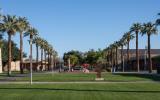Policy and Practice
Whether or not college pays off financially, and to whom, is an increasingly important question for institutions of higher education and their students. Career reasons are top motivators for students when deciding to enroll in postsecondary education, yet public perception has declined for the past five years regarding whether college is worth the cost (Lumina Foundation, 2023; Nguyen et al., 2024). This issue is especially salient for community colleges, underscoring the need for robust evidence that students of all backgrounds can attain positive post-completion career outcomes.
Measuring...

The global response to generative AI (GenAI) has been varied and dynamic. There is rapid adoption in some sectors, cautious exploration in others, and a growing push for regulation. Businesses and educational institutions worldwide are leveraging GenAI to innovate and enhance productivity, from automating routine tasks to generating new content and insights. However, this enthusiasm is tempered by concerns over privacy, security, intellectual property, and the ethical implications of AI-generated content. Governments and regulatory bodies are beginning to respond, with the goal of...
December
2023
Each year in spring, almost all community college associations and organizations hold their annual conferences. From February through May, these conferences attract thousands of community college administrators, faculty, sponsors, and assorted representatives from various organizations interested in the community college. The conferences are always an exciting time, where old friends meet, new friends are made, and creative ideas are shared in hundreds of sessions and forums.
As President and CEO of the League for Innovation in the Community College (League) for 23 years, and having worked in...
Tags:

Glendale Community College (GCC) has become an affiliate of the Bee Campus USA program, designed to marshal the strengths of educational campuses for the benefit of pollinators. According to the Bee City USA website (n.d.), “Bee Campus USA affiliates make commitments to conserve native pollinators. Students, faculty, administrators, and staff work together to carry out these commitments and make their campus a better place for pollinators” (“Bee Campus USA Commitments” section).
GCC is the only college in Arizona to be named as a Bee Campus and joins with other cities and campuses across the...

On February 3, 2021, I participated in a California panel discussion hosted by the Community College Research Center (CCRC) at Columbia University that addressed the cost benefits of adopting a guided pathways model. The discussion focused on two CCRC reports: The Economics of Guided Pathways: Cost, Funding, and Value (Belfield, 2020) and Funding Guided Pathways: A Guide for Community College Leaders (Jenkins et al., 2020). Based on my experience as President of Bakersfield College (BC), I assert that both reports can be extremely useful for administrators responsible for budgets, best...

According to Inc. magazine (Curtain, 2017), the number one skill that high paying employers want in employees is the ability to solve complex problems. At Wake Technical Community College in Raleigh, North Carolina, we are striving to help students develop problem-solving skills with the support of staff and faculty across the college through Student Applied Benchmarking (SAB). Students in this program design solutions to problems with the help of college employees. The culmination of this collaborative effort is the SAB Showcase, an event that provides students with the opportunity to...

Community colleges enroll over half of the undergraduate students in U.S. higher education and increasingly serve as the gateway to a postsecondary credential, particularly for first-generation and underrepresented students. As noted by researchers (Astin, 1984; McClenney & Marti, 2006; Tinto, 1993), student engagement within and outside of the classroom setting remains central to an institution’s ability to advance student success. At the same time, the growing demographic diversity of community college student bodies means there is no one-size-fits-all institutional approach to...

Since the launch of the American Graduation Initiative in 2009, the call to increase college graduation rates and to create a better educated workforce for the jobs of the future has become nearly universal. According to Former President Obama, speaking at the University of Texas on August 9, 2010, “in a single generation, [the U.S. has] fallen from first place to 12th place in college graduation rates for young adults" (as cited in de Nies, 2010, para. 3). He advocated for America to “once again have the highest proportion of college graduates in the world” by 2020 (as cited in Fry, 2017,...

Meeting the demand for quality professional development programming in times of constrained resources created an opportunity for innovative and creative thinking at Central Piedmont Community College (CPCC) in Charlotte, North Carolina. Over 1,200 full-time employees at CPCC are required to complete 20 hours of professional development credit annually, and all full- and part-time employees—more than 1,800—must complete a series of three required annual trainings, thus creating a demand for over 60,000 hours of professional development opportunities annually.
This demand occurs at a time of...










